Chapter 10: How to Start Investing in Mutual Funds?
We started our learning journey by understanding the history of mutual funds and how it has evolved in India. Later we learned how a mutual fund works and the types of Mutual funds available today to deploy your savings and invest them for wealth creation.
Mutual Funds allow you to kick-start your investing journey with relative ease since this instrument is so easy to understand. And the best part is, you can start investing in Mutual funds with as low as 100 Rs a month and increase it gradually as and when you can step up.
Yes, you heard it right! There’s no maximum limit but you can simply start your investing journey with as low as 100/- per month with mutual fund investing. Whether you’re a student or a salaried employee, a seasoned businessman or a homemaker – Mutual funds are the most affordable, efficient and systematic way to start with your financial planning journey.
By choosing a mutual fund you deploy your hard-earned savings into funds that invest in various underlying assets thereby diversifying your risk. The funds you choose to invest in are managed by professional fund managers who are highly trained and experienced and will be deploying your money after doing a lot of research and analysis.
All this and that too at a super affordable cost and now simply with a click of a button at the comfort of your home, office or any place in the world.
In this chapter, we are going to discuss how you can start your mutual fund investing journey.
Eligibility
If you are looking to apply for mutual funds, make sure you fulfill the following requirements for Mutual Fund investments of the platform/banks that you choose
Here is the eligibility criterion for mutual funds:
- The applicant can be an Individual, Non-Resident Individual (NRI), Hindu Undivided Family, or a Corporate Entity (rules and regulations and documentation process may differ)
- The applicant needs to be KYC-compliant
- Should have a Savings Bank Account & its status has to be Single or Either/Survivor.
- For all the non-individual categories – (certain rules and regulations are applicable which we shall discuss some other time)
KYC - Know Your Customer
What is KYC (know your customer), you may ask?
KYC or Know Your Customer is a customer identification process. The Securities and Exchange Board of India (SEBI) has laid down guidelines under the Prevention of Money Laundering Act 2002, which makes it binding for financial institutions and financial intermediaries like mutual funds to acquaint themselves with their customers.
The KYC process helps prevent money laundering and other suspicious transactions. With effect from January 1, 2012, all categories of investors irrespective of amount of investments in mutual funds are required to comply with KYC for carrying out any transactions in Mutual Funds.
Thus, all applicants investing into mutual funds would be required to be KYC compliant by any KYC Registration Agency (CAMS, KARVY, CVL, NSE or NSDL) without which the transactions may be liable to be rejected by the respective mutual fund houses.
Please note KYC norms are mandatory for ALL applicants/investors (including existing investors and joint holders) while investing with any SEBI registered mutual Fund, irrespective of the amount of investment.
Ways to Invest in Mutual Funds
Here’s how you can start.
Step 1
You can invest in mutual funds by submitting a duly completed application form along with a cheque or bank draft at the branch office or designated Investor Service Centres (ISC) of mutual Funds or Registrar & Transfer Agents of the respective mutual funds.
OR
You may also choose to invest online through the websites of the respective mutual funds.
OR
You may invest with the help of/through a financial intermediary i.e., a Mutual Fund Distributor registered with AMFI, or choose to invest directly i.e., without involving or routing the investment through any distributor.
A mutual fund distributor may be an individual or a non-individual entity, such as a bank, brokering house, or online distribution channel provider.
PS – To get higher returns you can choose direct investing of mutual funds through Dhan!
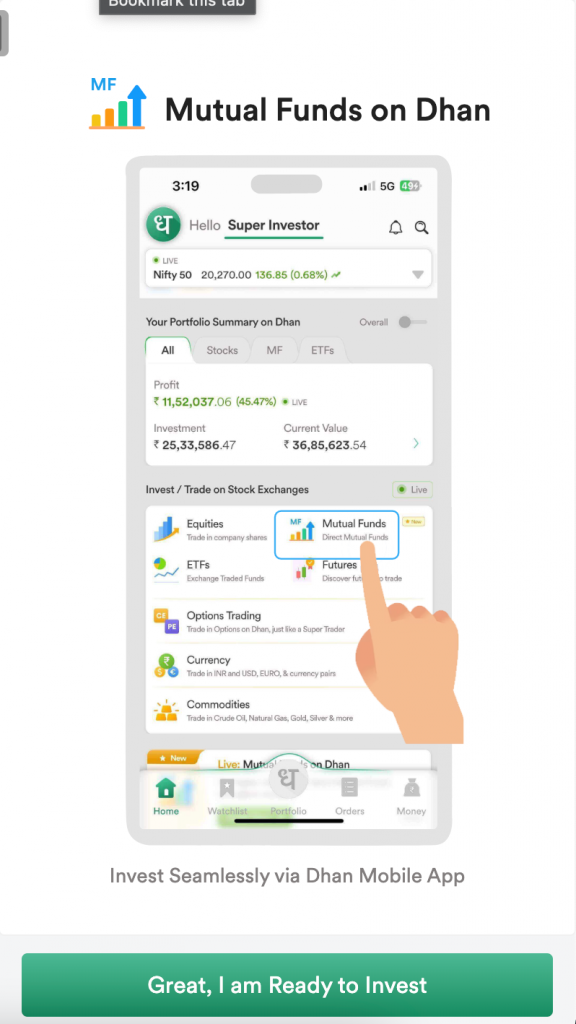

Dhan is one of the top platforms that offers more than 10000+ Direct Schemes that too with Zero Transaction Fee or Brokerage. With Dhan, you can generate higher returns by choosing direct funds which have very low costs.
Step 2
Let’s say you choose the Dhan to get started after submitting all the documentation as prescribed. You’re all set to getting started.
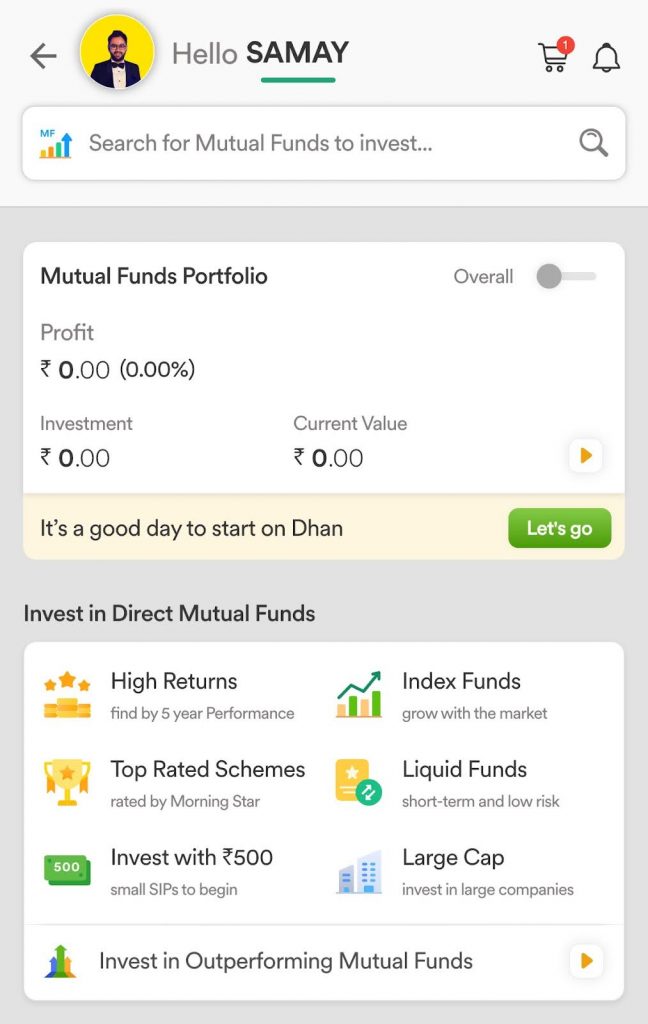
The platform gives you an array of options to choose from and not only this, the app also filters the 10000+ schemes into various categories for you which you can choose to narrow down on funds which suit you the best.
You can choose to invest in funds:
- That have generated higher returns in the past 5 years
- That are top rated schemes by various reputed agencies like Morning Star
- That are simple like index funds, large cap funds, or liquid funds
Just one click on these tabs and the platform sorts all the data for you at your disposal.
Dhan also offers you to explore. You can discover over 1000+ schemes that fall under various categories based on the underlying asset.
For example, the app filters all the equity funds for you. If you’re looking for funds that can help you to save taxes, just explore the Tax Saver category and the app will display all the fund options to choose from.
Similarly, you can filter funds in categories like Debt, Hybrid, etc., all in one single screen!
The app also allows you to discover which mutual fund companies are coming up with a New Fund Offering and you can also invest in them through the app itself. Gone are those days when you had to fill up forms and submit them to the nearest centers or your mutual fund distributors.
New Fund Offering
A New Fund Offer (NFO) marks the launch of a new mutual fund scheme, inviting investors to subscribe to its units at an initial price.
Some more Features – The app also Filters the mutual fund schemes by the Top AMCs so if you wish to choose your favorite AMC and look at all the schemes they have to offer, just click on the AMC tab and everything will be on display!
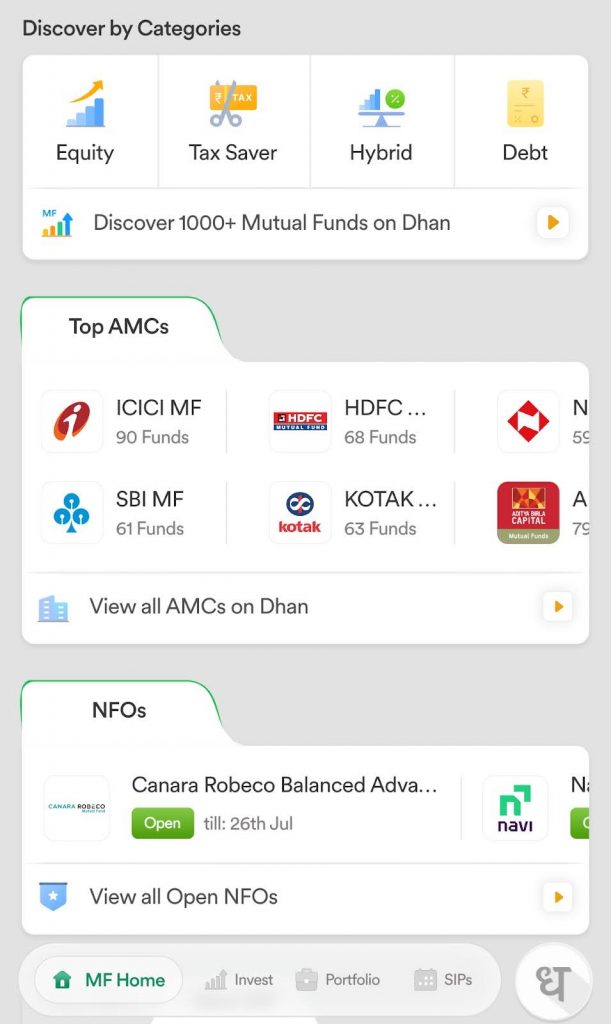
They say time is money and the app helps you save a lot of time as you can bookmark your favorite mutual fund scheme while you conduct your research and review it later. Not only this, but all the financial statements that you may need later are also seamlessly generated with just a click.

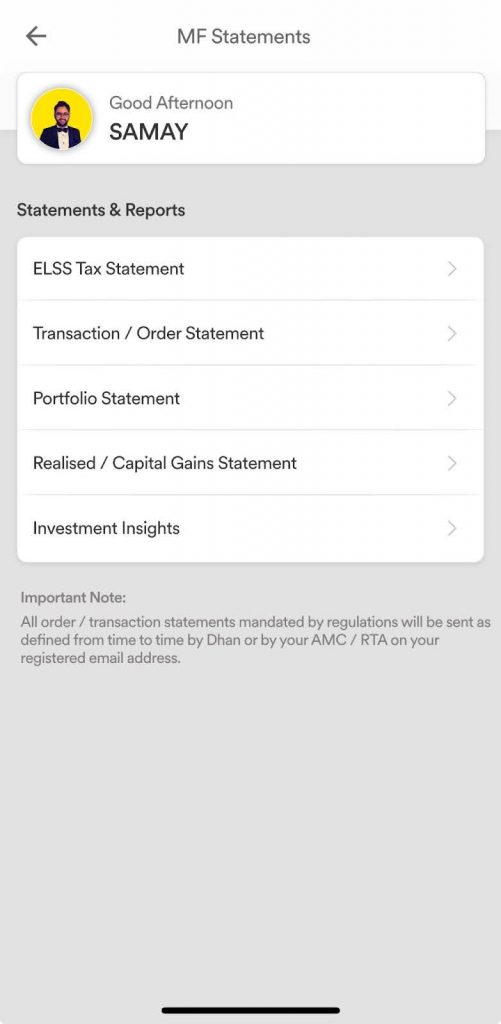
Let’s now understand the 2 ways in which you can choose to start investing in mutual funds.
Lump sum investing
Once you choose the fun , choose the amount you want to invest and then just make payments from your preferred mode of payment. Your transaction gets through and the app does the needful to process your transaction, at zero cost.

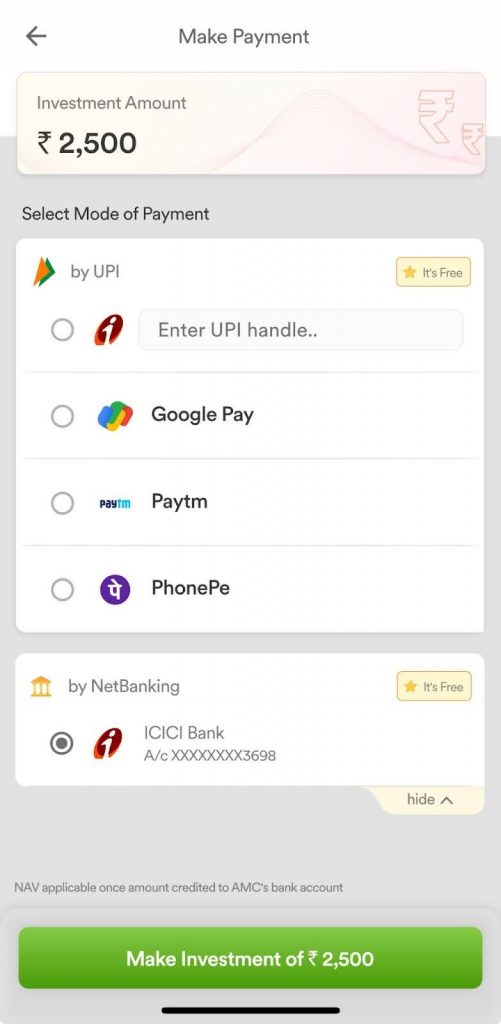
SIP (Systematic Investment Plan) investing
This is ideal if you wish to choose a scheme and invest in that scheme systematically at periodical intervals ( you can choose your SIP Interval – daily, weekly, monthly….)
Let’s say you want your money to be deducted every month and on the 10th day of every month – simply select the amount, choose the date of the month and choose the preferred mode of payment and it’s done.
The 1st instalment will follow through but what you will also need is a bank mandate.
The mandate allows the bank to automate your investments. A bank mandate is a process that allows the bank to auto-debit your monthly instalments.
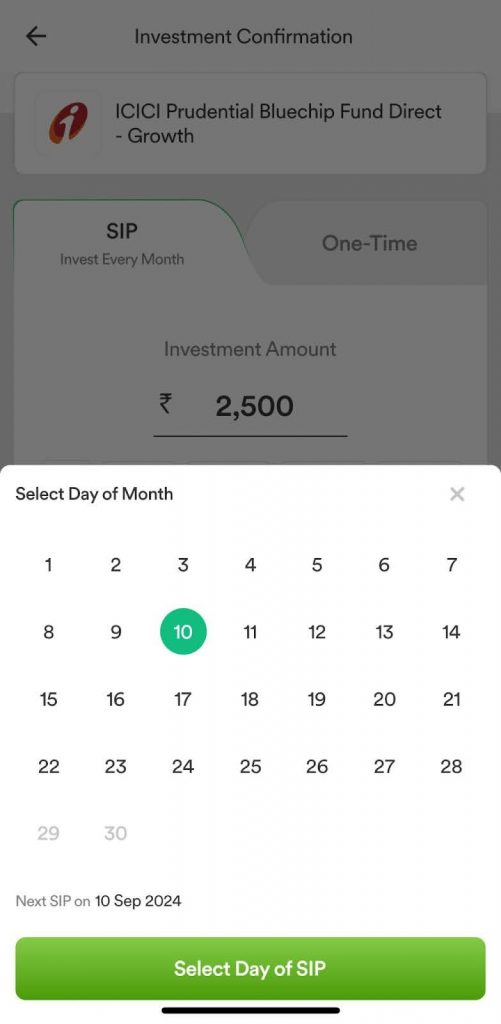
Once you set the mandate – the app also shows your monthly upcoming installments and the total SIPs (if you have more than 1 schemes in which SIPs are active)

Conclusion
Investing in mutual funds has never been so easy, all thanks to these new age tools that seamlessly allows you to invest in mutual funds without any hassle.
In the next chapter we shall understand how to track your mutual fund post investing.